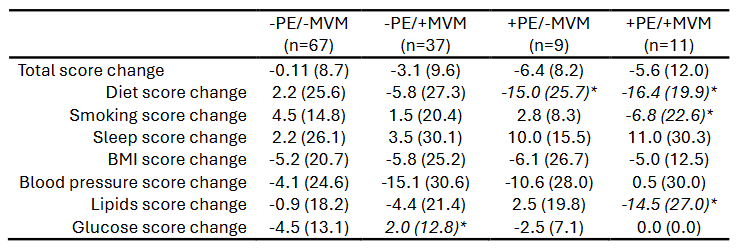Final ID: P2140
Changes in Cardiovascular Health in Midlife Following a Pregnancy Complicated by Preeclampsia and/or Placental Maternal Vascular Malperfusion Lesions
Abstract Body: Introduction: Preeclampsia (PE) with or without evidence of maternal vascular malperfusion (MVM) lesions in the placenta is a key risk factor for future maternal cerebrovascular and cardiovascular disease, and midlife is a crucial time during which subclinical disease may be developing. However, the trajectory of traditional risk factors in midlife following PE and/or MVM is not clear. We aimed to identify whether differential midlife changes in cardiovascular health were evident in those with or without PE and/or MVM to inform future intervention strategies.
Methods: Participants (38.3±6.1 years, 33% racial/ethnic minority) with and without PE and/or MVM (-PE/-MVM, n=67; -PE/+MVM, n=37; +PE/-MVM, n=9; +PE/+MVM, n=11) were assessed 9.2±0.9 and 14.5±0.8 years following the index pregnancy. Cardiovascular health scores (0-100, higher is healthier) were generated using seven of the Life’s Essential 8 components: diet, smoking, sleep duration, body mass index (BMI), blood pressure, lipids, and glucose. Linear mixed effects regression assessed changes across time between PE/MVM exposure groups.
Results: No significant differences in change across time were found between PE/MVM exposure groups for the overall cardiovascular health score (p=0.09), but the +PE/+MVM group demonstrated significantly more deterioration in component scores for diet, smoking, and lipids compared to the -PE/-MVM group (Table). The +PE/-MVM group also demonstrated significantly worsening diet scores, while the -PE/+MVM group showed a significant improvement in blood glucose scores compared to the -PE/-MVM group.
Conclusions: Those with PE, both with and without MVM lesions, appear to demonstrate a worsening cardiovascular health profile in middle age driven by modifiable components including diet, smoking, and cholesterol. Interventions to encourage healthy behaviors and lipid control should be considered in this time frame, as they may be impactful to prevent disease progression.
Methods: Participants (38.3±6.1 years, 33% racial/ethnic minority) with and without PE and/or MVM (-PE/-MVM, n=67; -PE/+MVM, n=37; +PE/-MVM, n=9; +PE/+MVM, n=11) were assessed 9.2±0.9 and 14.5±0.8 years following the index pregnancy. Cardiovascular health scores (0-100, higher is healthier) were generated using seven of the Life’s Essential 8 components: diet, smoking, sleep duration, body mass index (BMI), blood pressure, lipids, and glucose. Linear mixed effects regression assessed changes across time between PE/MVM exposure groups.
Results: No significant differences in change across time were found between PE/MVM exposure groups for the overall cardiovascular health score (p=0.09), but the +PE/+MVM group demonstrated significantly more deterioration in component scores for diet, smoking, and lipids compared to the -PE/-MVM group (Table). The +PE/-MVM group also demonstrated significantly worsening diet scores, while the -PE/+MVM group showed a significant improvement in blood glucose scores compared to the -PE/-MVM group.
Conclusions: Those with PE, both with and without MVM lesions, appear to demonstrate a worsening cardiovascular health profile in middle age driven by modifiable components including diet, smoking, and cholesterol. Interventions to encourage healthy behaviors and lipid control should be considered in this time frame, as they may be impactful to prevent disease progression.
More abstracts on this topic:
Adverse Cardiovascular Outcomes in the Postpartum Period Associated with Upbringing-Related Social Determinants of Health
Tolu-akinnawo Oluwaremilekun, Anuforo Anderson, Ezekwueme Francis, Ogunniyi Kayode, Awoyemi Toluwalase
Adherence to Pediatric Screening Guidelines for Cardiovascular Risk Factors in a Diverse Cohort of Children in ChicagoGauen Abigail, Wang Yaojie, Perak Amanda, Davis Matthew, Rosenman Marc, Lloyd-jones Donald, Zmora Rachel, Allen Norrina, Petito Lucia

